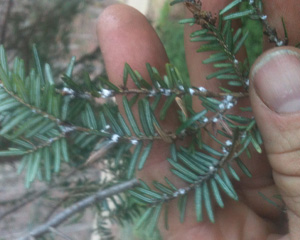
HWA in Brattleboro
Hemlock Woolly Adelgid is an invasive insect that effects our Hemlock trees. It has deforested vast tracks to our south, but has just recently gotten a foothold in Windham County. It’s a good idea to check your hemlocks by turning over the limbs and looking for little white cotton balls at the base of the needles. These are the waxy protective structures that the eggs mature in. When the insects hatch, they will crawl to a new needle, and begin sucking nutrients from the hemlock. Trees tend to yellow and decline, and can eventually die. Because they help cool streams and lowlands, and provide unique and valuable habitat for deer and many species of birds and mammals, hemlocks are a very important component of our ecosystem.
The good news is that there are solutions for the hemlock trees in your yard, and advances are being made toward helping hemlock in forest lands. You can call or email All About Trees for a free consultation, and there are steps you can take on your own.
- be familiar with your hemlock trees, and check the undersides of the branches, especially in November and March-April when the egg sacs are at their fluffiest.
- If you think you might have HWA on your trees, call a certified arborist to help verify and track the insect.
- take down birdfeeders and birdbaths in between April and the end of August. Birds are known to spread HWA
- stressed trees succumb more quickly to the adelgid. Water and mulch your hemlocks, but don’t fertilize them. Fertilizing hemlocks with HWA is counterproductive, because it increases adelgid feeding and reproduction
There are a number of treatments for hemlock wooly adelgid, and the best one will depend upon the particular tree and circumstances. Smaller trees can be sprayed with either horticultural oil or an insecticidal soap, which suffocates soft bodied insects like adelgids. For larger trees, certified professionals usually use systemic solutions. These treatments can be absorbed by the tree through it’s bark or from the ground surrounding the trunk, and provide longer-term protection than oils and soaps.
Hemlock trees offer the greatest aesthetic and ecological benefits in their maturity. It’s worth protecting trees that have withstood the tests of time. All About Trees can offer you the broadest range of options for protecting your landscape and trees.
